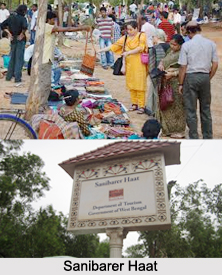 Sanibarer Haat is a weekly market held in Saturday every week throughout the year except in monsoon times. It is the place where various handmade items, organic vegetables and homemade food items are sold on weekly basis. Unlike any other shops or markets, here the producers bring in their weekly produces, which are solely prepared by the sellers and their families.
Sanibarer Haat is a weekly market held in Saturday every week throughout the year except in monsoon times. It is the place where various handmade items, organic vegetables and homemade food items are sold on weekly basis. Unlike any other shops or markets, here the producers bring in their weekly produces, which are solely prepared by the sellers and their families.
This market place projects rural Birbhum, now popular among the international tourists. It is also known as "Amader haat" or Bondanga"r Haat which takes place every Saturday in Khowai or the famous stretched valley of undulating laterite land formation dotted with beautiful Sonajhuri trees near Santiniketan and the Prantik Ashram. The landform here shows the natural beauty of Kopai river and the crest and trough that has been made naturally.
Sanibarer Haat is an open air affair and starts in the afternoon depending upon the heat and the sunrays, sometime at 2:30 if it"s cloudy or at 4 if it"s very hot, and stays as long as there is sunlight. The sellers gather from the surrounding villages and seat on the grass under the shade of the Sonajhuri trees. The products ranges from various jewelleries made from terracotta, dokra or seeds, Kantha embroidered sarees or artifacts, locally made musical instruments, slate carvings, and wooden artifacts to organically grown vegetables or traditional food items. The sellers use local raw materials and craftsmanship. Many sellers from Kolkata, Bihar, Ranchi and Mumbai used to buy these products from this Saturday market and sell them worldwide.
Sanibarer Haat celebrates every week the harmony of Bengali culture in a unique way to revive Indian traditional arts and crafts for a long-term survival. Now this market only is popular among the Bengali people as it projects in many Bengali movies. Saturday Market become popular in America, England and France.



















